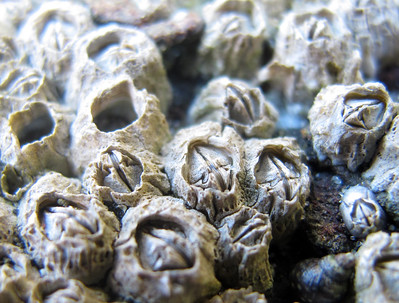Sweep, sweep, sweep…
When the sea returns to a barnacle’s home, the barnacle will open the two doors in the center and extend its ten feathery legs beyond the protective walls. Opening and closing at a measured pace, the barnacle’s curved legs sweep the water for its food: plankton and detritus. Find some barnacles still submerged in a quiet tidepool and you’ll be able to watch the graceful dance.
 With the doors tightly shut and the walls intact, the barnacles are protected from drying out and from many potential predators, and are protected from heavy surf. Almost as hard as the rocks they’re attached to, barnacles hard enough to scratch and cut people, but soft enough to be easily crushed by scuffing feet and walking sticks: Please take care to not get cut by the barnacles or to crush them.
With the doors tightly shut and the walls intact, the barnacles are protected from drying out and from many potential predators, and are protected from heavy surf. Almost as hard as the rocks they’re attached to, barnacles hard enough to scratch and cut people, but soft enough to be easily crushed by scuffing feet and walking sticks: Please take care to not get cut by the barnacles or to crush them.
These barnacles may attach to anything hard, including driftwood, mussels, black turban snails and other molluscs—even the backs of crabs.
Oregon’s tidepools are home to several species of barnacles, each with a slightly different texture and door shape. If a patch of barnacles grow long enough and big enough, they’ll crowd each other and be forced to grow upwards only, with each barnacle becoming tall and narrow.
